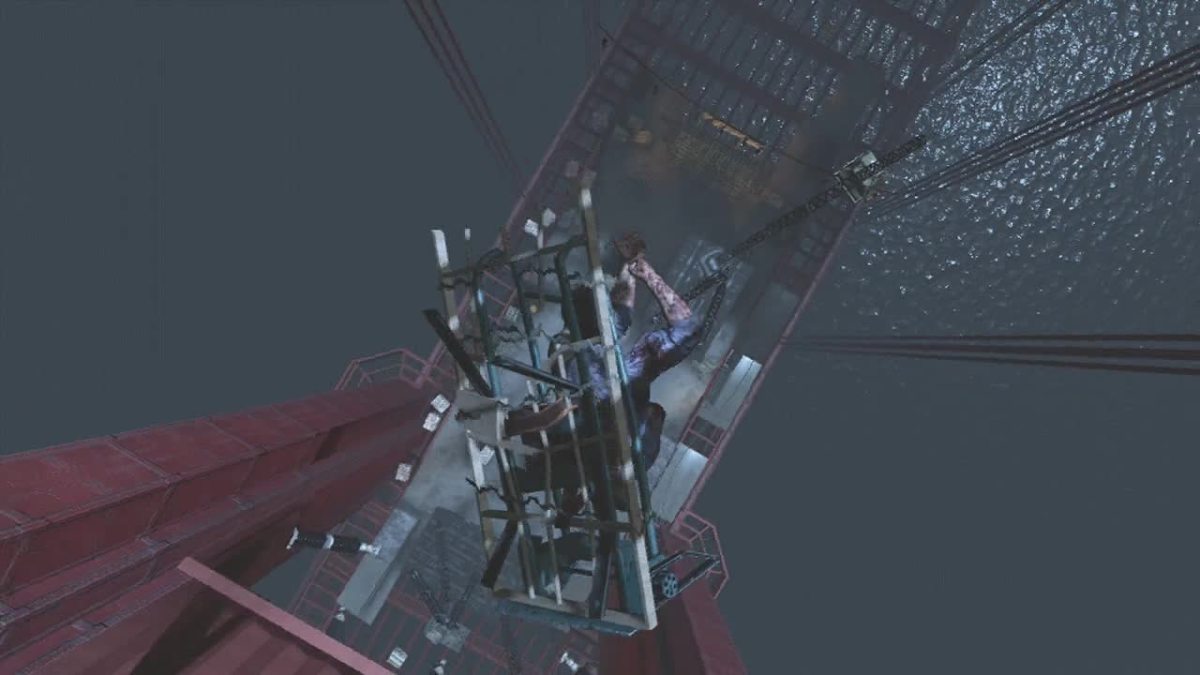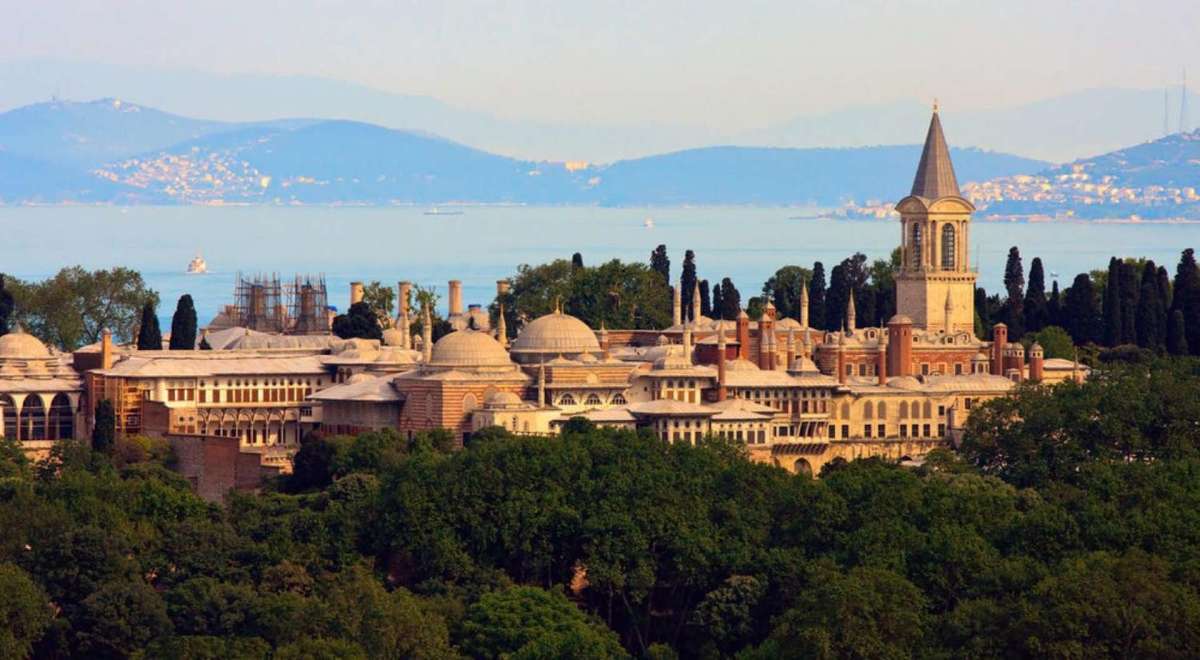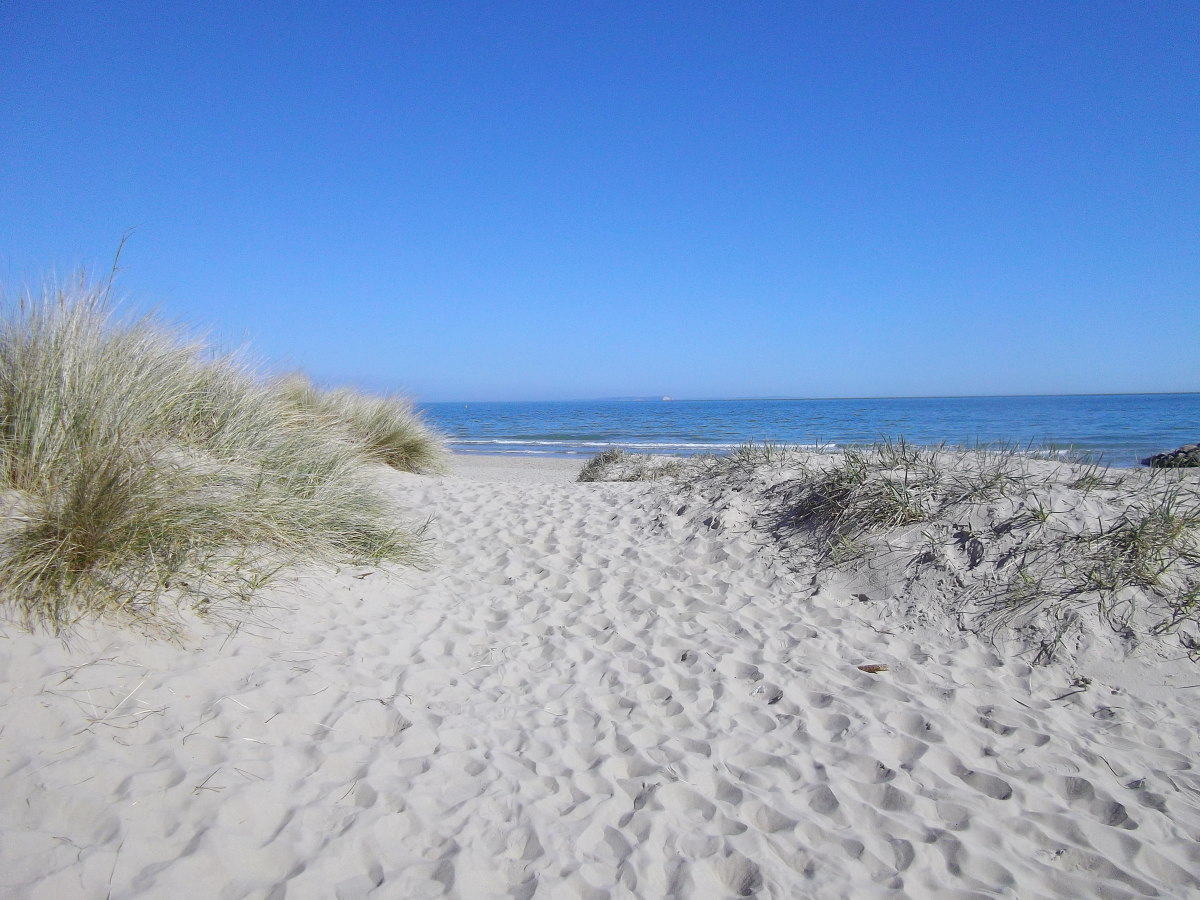White Stone and Golden Gate - Welcome to the Diocletian's Palace in Split, Croatia
The UN protected Palace - a UNESCO World Heritage Site!
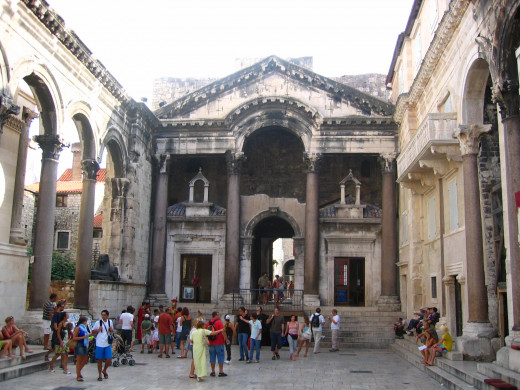
A Do it Yourself Walking Tour of the Palace
DIY - take your time and check out points of interest...
So you've been hearing about this great ancient palace, amazingly intact and in remarkably good condition for its 1700 years. Built in the "late ancient era" which is characterized with the Diocletian himself, this was his retirement home. It was constructed in 20 years' time (fast for ancient times) and was never invaded.
It has been a great historical resource for the people who lived here before and during the Roman Empire's rule. Here is a recommended walking route to catch its highlights in about 1-1/2 hour's time.
From "Palace" to "City"
The Palace itself marked the beginnings of the town of Split, though on the map Tabulus Pentagiuarus the area was already referred to as "ASPALATHOS" or Aspalatos, - which was later shortened to Spalatos. From that name evolved the word Split. With invaders - wars, plague - the Turks - and most recently the devastating war for the homeland, the city's indominable spirit continues to thrive. Since ancient times, It has been existence for 1700 years.
The Diocletian lived most of the year from his palace in Nikomedija (Nicomedia) in modern day Turkey. The two Palaces were largely similar. The Diocletian ruled the Eastern half and Maksimijan ruled the western half from an area not far from modern day Milan.
The Legendary Diocletian
- Diokles, the Diokletian - the Soldier who became Roman Emperor - a Biography
Humbly born Iliric soldier Diokles rose in the military ranks of the Roman Empire to become its unlikely Emperor. He proved to be an excellent manager. In his twenty years' reign, he reorganized all matters military, civilian, financial and cultural.
Start on the South Side of the Palace
There is a huge map of Split (think - glass billboard) showing the Palace. This is a great place to start. Opposite the palace itself is a green belt, white picnic benches and a coffee shop. When you are ready to begin your tour of the Palace, simply cross the street and enter the Southern Gate, known as the Bronze Gate or the Honey Gate.
- The Bronze Gate (South) of the Diocletian's Ancient ...
The Bronze, or Honey Gate was placed on the southern side of the Diocletian's Palace. The private entrance for the Diocletian and his family, it led to his substructure (basement) and storage area, arched reinforcements showing how the Emperor lived.
The Fabulous Substructure of the Palace
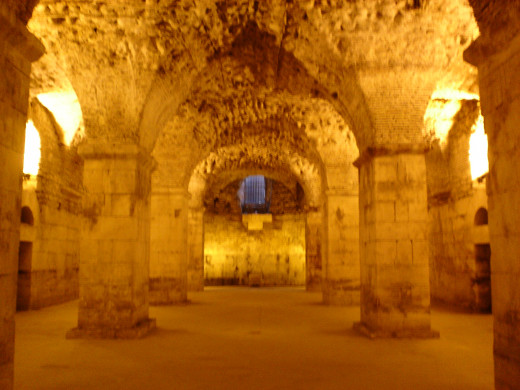
The Northern, or Golden Gate, of the Palace
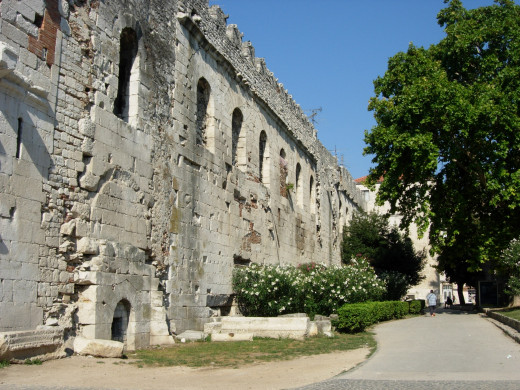
Under the Palace
After the Diocletian's death in 316 A.D., the Palace became state property. Three centuries later (we don't know the exact date), the Slavs and Avars came from the East and invaded the cosmopolitan town of Salona, just a few kilometers north of Split. The survivors at first sought refuge on the neighboring islands, but after some time, and with permission, they entered the Palace and lived in the substructure. At that time the archdiocese of Salon was transferred to Split, where it remains to this day. This was in the 7th century, around 650 A.D. or a little after.
Here you will find massive arched ceilings which are rumored to be the inspiration for modern church design from the days of early Christianity. Immediately to the left, we go into a passage (there are 60 rooms connected by passages) leading to an ancient residential zone occupied by the ex residents of pillaged Salonita, among the first residents of Split as a municipality.
Remnants of this time are still visible. Olive presses and amfora (ancient jugs) used for storage and transportation are still visible. The substructure was divided into an upper and lower half. They worked in the lower half and lived in the upper, warmer half. To this day, houses in Dalmatia have a similar correlation. The downstairs konoba or wine cellar is used to store homemade wine and to work. The upstairs is usually where the sleeping rooms are located.
In the next area we can look above and see large holes in the ceilings. These were - you guessed it - ancient toilets! One of the reasons why the substructure is in such excellent condition is due to the amounts of organic and inorganic material stored inside. It was packed to the gills when excavation attempts began in the late 19th century by an archeologist-priest named Don Frane Bulić who is responsible for getting it, and other archeological digs, including ancient Salona initiated. Salona today is a fascinating place to visit with impressive ancient ruins, located right outside of modern day Solin.
Riddle of the Sphinx
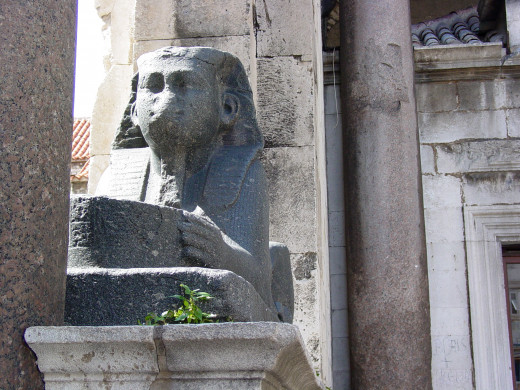
Upstairs / Downstairs
The Diocletian's dining room was upstairs, which is now destroyed but we can imagine what it looked like based on the substructure. Upstairs and downstairs were identically built. This is the great value of the substructure. It gives a lot of clues that we ordinarily wouldn't have about ancient life.
Stone Grave Replica
In a separate small room we see a replica of the Diocletian's sarkofag, or stone grave. They resemble large stone caskets, which they were, and were buried or left outside the church door. This was an honor reserved for wealthy benefactors to the church, as may be the case at Jupiter's Temple on the Peristil, where an impressive looking stone carved grave sits near the entrance. Hence the expression "stinking rich".
Days of Antiquity
Split's Famous Riva
Bronze Gate
Enter the Palace from the Southern Gate, proceeding through the Substructure to the Peristil
Nowadays, when leading a tour of the Palace, it's wise to start out at the Southern Gate, facing the sea. In ancient times, the Palace was situated against the sea, although historians say the drawing tend to exaggerate its closeness. There was room to walk along the coast. Today there is a long coastal walkway with palm trees, coffee shops, bakeries and bookstores. There is plenty of room for strolling, people watching and conversation. Pidgeons come to the Riva for bread crumbs, and for those who live close by, a walk on the Riva is a normal part of the day, be it morning, afternoon or evening.
The Sunny People's Square or the PEE-YAT-SA
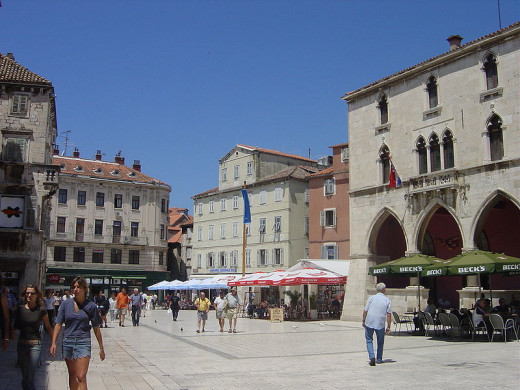
People's Square (Narodne Trg)
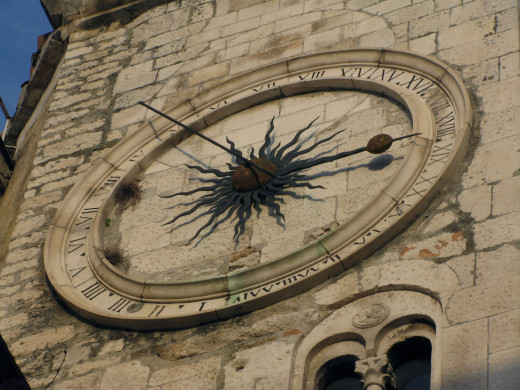
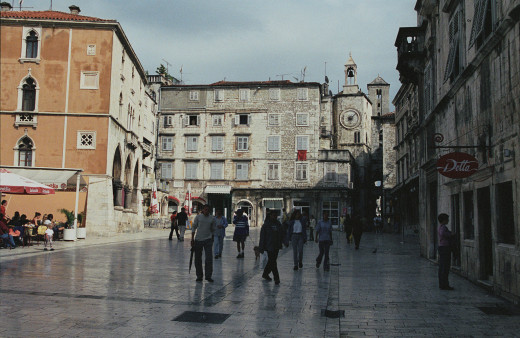
Left onto the Piaca - the "New Town"
After leaving the Peristil, turn left towards the Piaca. Pee-AT-za. There you will find beautiful baroque Palaces, most of which were built in the 16th and 17th century during the Middle Ages. To get there, you must first pass through the historical iron gate - with churches dating back to the 5th century. A medieval form of onsite court during the early Renaissance. In this courtyard are traces of ancient goddess Nike from the Roman pagan beliefs, one of the oldest Romanesque churches in the world - St. Theodor - and its follow up church Gospa Zvonik, our Lady of the Bell Tower - which was erected in the 11th century. More details in the link below.
As the city swelled, the Palace was too cramped to accommodate its citizens. The Piaca or Town Square was used as a new center of town. It lies directly outside the Iron Gate and is graced with many impressive "Palaces" built by residents of Split during the 16th and 17th centuries, as well as the 18th.
The Iron Gate
- The Iron Gate (West) of the Diocletian's Ancient Pal...
The Western Gate to the ancient Diocletian's Palace became a passageway to a new section of town in the Middle Ages. Split experienced a huge of growth due to its active importation between East and West. This brought the city prosperity, culture.
The Silver Gate (from the inside of the Palace)
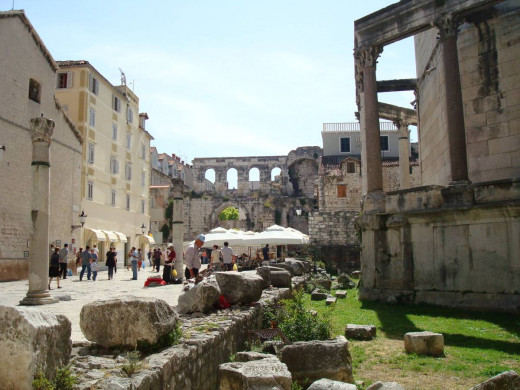
To the Get and the Golden Gate of the Palace
Next we will head to the northern section of the Palace, where the ancient clothes factory (or factories) were, during the Diocletian's day. There, they created cloth with a water-treatment processing which was accessible from the constantly flowing aqueduct. Water flowed at a rate of 1,100,000 m3 per day, enough to sustain 170,000 citizens. Of course, perhaps 10,000 or less occupied the Palace but it was a highly efficient system.
The Get
This area is now called the Get, which is short for Ghetto. It is a beautiful section of town with fountains, wine cellars, stone walkways and mosiacs, plants hanging down from balconies and an Old World flavor of Mediterranean life. Stop here and have a cup of coffee or dark Tomislav , beer, like the locals so. Tomislav was the name of an important Croatian King, you will see his magnificent statue in front of the train station outside in Zagreb. The Croatian kings ruled in the 9th, 10th and 11th century, between power struggles from the Austrian Hungarian Empire, Venetians, and the Turk invaders....
City Museum of Split
- Untitled Document
The wonderful City Museum of Split located in the Northern Section of the Diocletian's Palace. Click to see times of operation, admission fees, and schedules for special exhibitions and workshops for adults and children.
The City Museum of Split - see it before you go
Jure Dalmatinac - Renaissance Builder for the City Museum / Papalić Palace
Full of interesting artifacts, including a serving plate from the Diocletian's own dining room, the City Museum is open every day except Monday during the year, but double check for summer. Formerly owned by the Papalić family, it was one of the two Papalić Palaces. With its beautiful Mediterranean courtyard, it was also partially built by Jure Dalmatinac, who helped to build the grave of Blessed Arnir and the world famous Sibenik Cathedral in another coastal town a few kilometers up the coastline. it is so beautiful that it's often used in filming TV shows. With its Gothic windows and amazing artifacts covering the many stages of Split's development, including the French era and the bustling Renaissance. The artifacts and literature within it are highly recommended to look at and purchase if you wish - you cannot find books like this anywhere. Your visit requires about an hour's time.
On the same street as the Museum is Marko Marulić family home. More on him later. Now, onward to the main gate of the Palace, the Golden Gate or Portus Auerelius!
City of Split's Distinctive Coat of Arms
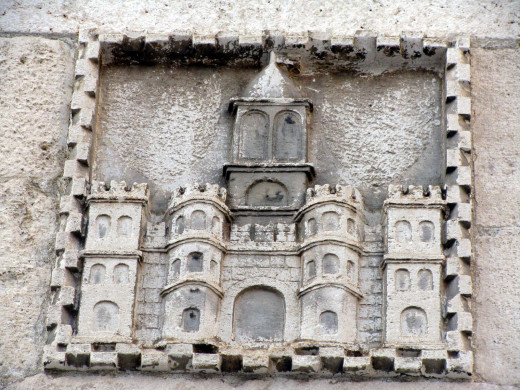
The Golden Gate
- The Golden Gate (North) of the Diocletian's Ancient ...
The North Gate or Golden Door to the Diocletian's Palace was the main passageway between Salona and Split. This door was heavily fortified, ornately decorated with statues. Outside its 1700 year old gates graces an imposing figure of Grgur Ninski.
Grgo Ninski - Bishop of Nin
The next point of interest is the huge and imposing statue of Grgo Ninski, who was an important historical figure in Croatian history. He is has a pointed cap and finger pointing upwards, as if to make a point. He is saying "this is a great victory for the Croatian language!". During his lifetime, he was a bishop or archbishop fighting for the rights of the Croatian Glagolic language to be admitted as the exception to the Latin used during the Catholic mass. Being the only Roman catholic country on the Balkan Peninsula, the people were granted permission to hear the mass in their native tongue, not Latin, which was a language for scholars. In the end, they probably said "hallelujah!"
Visitors to the palace love to follow a tradition of rubbing his big toe and making a wish.
Gregory, Bishop of Nin or Grgur Ninski

Backtracking to the Sea again
Now that we've seen the Golden Gate with its Tower of Blessed Arnir, (a Christian martyr), Church of Saint Eufemia and Seminary which was built by Jure Dalmatinac, it's time to head back. Returning through the Golden Gate, we'll veer to the right and observe the Piaca and its statues built into the walls. There Saint Antun at the head of the Iron Gate.
Now we will walk towards the Sea where we first began and end up on the Voćni Trg, the Fruit Square or the Square of the Radić brothers, Croatian freedom fighters. On this square there are many amazing artifacts. First there is the Milezi Palace (Mil-lazy) which was a built between the Renaissance and Baroque eras. In the center of the square is an imposing status of Marko Marulić, an important Croatian figure. He was a humanist during the Renaissance, and is known as both the Father of Croatian literature (having printed the first book in Croatian - named "Judith") and the Father of Modern Psychology, being the first to coin the phrase "psychology". Here is a link with more information:
He wrote to the Pope asking for assistance from the Turks
- Marko Marulić - Renaissance Man from Split, Croatia and Father of both Croatian Literature and Moder
During the high Renaissance in Croatia, an age of Humanism prevailed and the city of Split's best known humanist was Marko Marulić. Honored on the Croatian 500 kuna note, he's called the Father of Croatian Literature.
Renaissance Man
- Petar Hektorovic - Croatian Renaissance Man, Noble, ...
Born in the middle ages, Peter Hektorovic was an author, conservationist, and political activist, as well as being a religious man. Nearly drowned by the Turks, he later build a fortress to protect his loved ones from the threat of Turkish invasion.



